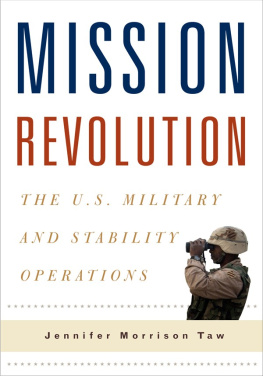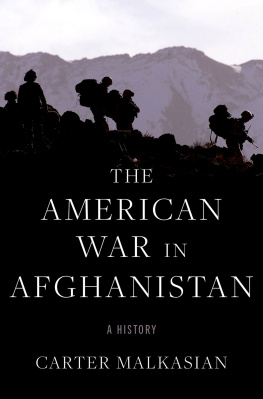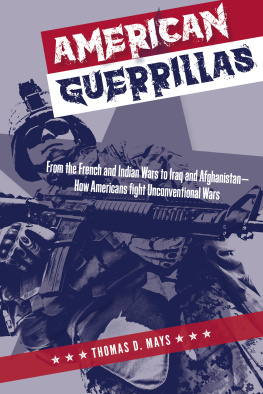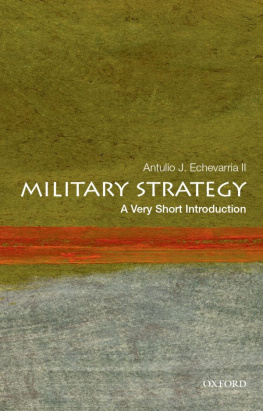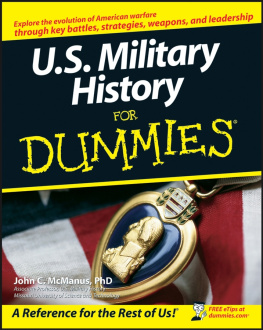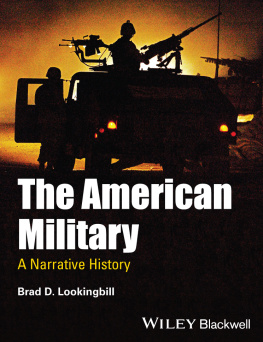Reconsidering the American Way of War
Reconsidering the American Way of War
US Military Practice from the Revolution to Afghanistan
Antulio J. Echevarria II

2014 Georgetown University Press. All rights reserved. No part of this book may be reproduced or utilized in any form or by any means, electronic or mechanical, including photocopying and recording, or by any information storage-and-retrieval system, without permission in writing from the publisher.
Library of Congress Cataloging-in-Publication Data
Echevarria, Antulio Joseph, 1959
Reconsidering the American way of war : US military practice from the Revolution to Afghanistan / Antulio J. Echevarria II.
pages cm
Includes bibliographical references and index.
ISBN 978-1-62616-067-5 (pbk. : alk. paper)
1. Strategic cultureUnited StatesHistory. 2. United StatesMilitary policyCase studies. 3. United StatesHistory, Military.
4. Strategy. I. Title.
U21.2.E32 2014
355.033573dc23
2013034006
This book is printed on acid-free paper meeting the requirements of the American National Standard for Permanence in Paper for Printed Library Materials.
15 14 9 8 7 6 5 4 3 2 First printing
Printed in the United States of America
To Jorge, who fought well.
Contents
Acknowledgments
I began framing the chapters of this book while on a visiting research fellowship through Oxford Universitys Changing Character of War program. I enjoyed the better part of a year at Nuffield College, which afforded me access to Oxfords vast research facilities and a collegial environment in which to work. My warmest thanks go to Sir Hew Strachan, Rob Johnson, Andrea Baumann, and Sibylle Scheipers, whose perspectives greatly enriched my own. I would also like to thank my friends and colleagues from the Society of Military History, many of whom gave of their valuable time to consider or debate some of the points in this study. All were helpful in that special way the society has of encouraging the research of its members, but Bianka Adams, Conrad Crane, Brian Linn, Randy Papadopoulos, Jill Russell, and Janet Valentine deserve particular mention. I am also grateful to Don Jacobs of Georgetown University Press for his professionalism in preparing this manuscript for publication.
Last and never least, my deepest appreciation goes to my family, whose patience was limitless over the long months I spent writing this book. To my wife Laurie and our children I owe a debt I can never repay.
Preface
This book of history is based on an assumption that what we believe and what we do today is governed at least as much by the habits of mind we formed in the relatively remote past as by what we did and thought yesterday.
Russell Weigley, The American Way of War, 1973
THIS BOOK CHALLENGES several longstanding notions about the American way of war. It examines American military practice from the War of Independence to the campaigns in Iraq and Afghanistan to determine what patterns, if any, exist in the way Americans have used military force against their adversaries. It argues that many beliefs concerning the American way of warsuch as its alleged apolitical and astrategic character and its reputation for using overwhelming force to achieve decisive resultsdo not, in fact, hold up to scrutiny. American uses of force were typically driven more by political considerations than military ones, and the amount of force employed was rarely overwhelming or decisive. Whereas Russell Weigleys celebrated work, The American Way of War, traced ideas about military strategy, this study concentrates on strategic and operational practice. Its premise is that what people did historically is just as revealing as, if not more than, what they thought or said. Accordingly this book closes the gap between Weigleys novel effort to represent Americas way of war as a history of ideas and the more grounded narratives of Americas diverse wars and military actions.
Focusing on strategic and operational practice helps strip away some of the rhetoric of the age, such as Gen. William T. Shermans oft-repeated phrase hard hand of war.different ways and for different reasons. Since those revolutions are behind us, we can now take a more objective look at what the American way of war was and in some ways still is. Hence the title of this book.
Weigleys American Way of War remains a classic. Even so, and even with his considerable skills as a historian, his history of ideas necessarily omitted much. We find little discussion of Americas supposed small wars, except for the campaigns against Native Americans, and those were not small when their geographic scope and duration are considered. Collectively they create a truer picture of how and why Americans used military force. For that reason, this book covers not only Americas major conflicts, but also many of its smaller wars and military actions (it was simply not possible to examine all of them) to offer a more comprehensive treatment of the American way of war.
This more comprehensive picture reveals that, of the many factors that drove American uses of force, perhaps the most important was an administrations desire to reduce its political risk. Rarely was the use of overwhelming force seen as a way to reduce risk. Instead, political leaders typically focused on committing only sufficient force. This rationale is counterintuitive from a military perspective, which considers it beneficial to enter a conflict with a preponderance of force. Ultimately what constituted an acceptable level of political risk to an administration was a subjective call. Presidents and their advisers took any number of internal and external factors into account when determining the degree of risk they were willing to accept. Such factors included an administrations sense of itself, how strong its mandate appeared, its assumptions regarding the efficacy of military force, and how confident it felt about its ability to fight a war while advancing its other policies. Thus the chief characteristics of the American way of warand how they changed over timewere determined largely by the major tensions and dialectical turns in American politics. The American way of war was, and still is, thoroughly political.
Contrary to the received view, the American way of war was also not astrategic. American strategic and operational practice became more fused over time. The latter incorporated the former in war plans and campaign plans or, more precisely, within the various sections detailing the schemes of maneuver for such plans. This development did not mean that military strategy was consumed by operational art, as some claim. Yet within that overarching strategy, it was also possible for Gen. Douglas MacArthur and Adm. Chester Nimitz to pursue strategies of position in designing their respective campaigns, even as they carried out force-oriented strategies aimed at destroying Japanese combat power. Strictly speaking, strategies of position and control do not preclude the use of force-oriented strategies or vice versa. Yet the distinction provides a useful framework for discussing the variety of military strategies that made up American military practice. The downside of such variety is that, without strong coordination at the top, nested military strategies can become disjointed, with each of the armed services pursuing separate strategic agendas. That, in fact, happened to a degree in several American conflicts.
The American way of war, though manifold in its features and characteristics, is at root a way of battle precisely because it places decisive operations at the core of its conception of war and often expects to win wars by virtue of winning battles. This is not to say that winning or losing battles is trivial or irrelevant. Battles or engagements are often the principal currency in the exchanges that take place among belligerent parties. Nevertheless, the link between victory on the battlefield and overall success is not automatic, as contemporary US doctrine tends to assume.
Next page

